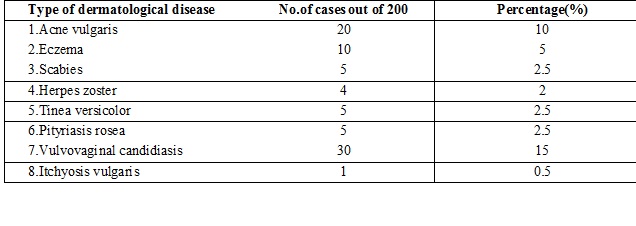Cutaneous manifestation in pregnancy
Abstract
Back ground: During pregnancy there is immunologic, metabolic, endocrine and vascular changes responsible for physiological and pathological skin changes.
Aims and Objectives: The objectives of the study to determine the pattern of the skin changes associated withpregnancy and to examine in detail both physiological and specific dermatosis. To identify the various clinical types of pregnancyspecific physiological changes and to know the proportion of these cutaneous manifestation in pregnant women.
Materials and Method: The study was a cross sectional study carried out at the out patient department of gynaecological and obstetrics at Adhichunchanagiri Institute of Medical Sciences, Bellur, Karnataka. Study was a period of 6 months. A total of 200 pregnant females, irrespective of their parity and gestational age were examined for any dermatological complaint.
Result: The age of the study population ranged from 17 to 39 years (mean=24years), the study population included 200, (60%) primigravida, 40% multigravida. Skin changes were grouped in to: physiological changes (all cases), other dermatoses affected by pregnancy (80 cases), specific dermatoses (20 cases). Most common physiological changes were pigmentary alteration 184 cases (92%), followed by straie seen in 172 cases (86%). Of the various specific dermatoses of pregnancy, Pruritic utricarial papules and plaques of pregnancy was the most common disorder (13 cases), followed by Pruritus gravidarum (6 cases). The most common dermatoses affected by pregnancy Vulvovaginal candidiasis (30 cases), acne vulgaris (20 cases), eczemas (10 cases).
Conclusion: Pregnant women are prone to suffer from a wide range of dermatological problems apart from specific dermatoses of pregnancy. The study emphasizes the need for a detailed and meticulous examination of these patients to detect various disorders.
Downloads
References
2. Shornick JK, Bangert JL, Freeman RG, Gilliam JN. Herpes gestationis: clinical and histologic features of twenty-eight cases. J Am Acad Dermatol. 1983 Feb;8(2):214-24.[pubmed]
3. Martin AG, Leal-Khouri S. Physiologic skin changes associated with pregnancy. Int J Dermatol. 1992 Jun;31(6):375-8.[pubmed]
4. Kumari R, Jaisankar TJ, Thappa DM. A clinical study of skin changes in pregnancy. Indian J Dermatol VenereolLeprol. 2007 Mar-Apr;73(2):141.[pubmed]
5. Raj S, Khopkar U, Kapasi A, Wadhawa SL. Skin in pregnancy. Indian J Dermatol Venereol Leprol. 1992;58:84–8.[pubmed]
6. Shivakumar V, Madhavamurthy P. Skin in pregnancy. Indian J Dermatol VenereolLeprol. 1999 Jan-Feb;65(1):23-5.[pubmed]
7. Muzaffar F, Hussain I, Haroon TS. Physiologic skin changes during pregnancy: a study of 140 cases. Int J Dermatol. 1998 Jun;37(6):429-31.[pubmed]
8. Roger D, Vaillant L, Fignon A, et al. Specific pruritic diseases of pregnancy. A prospective study of 3192 pregnant women. Arch Dermatol. 1994 Jun;130(6):734-9.[pubmed]
9. Puri N, Puri A. A study on dermatoses of pregnancy. OurDermatol Online.2013;4:56–60. 130:734–9.
10. Hassan I, Bashir S, Taing S. A clinical study of the skin changes in pregnancy in Kashmir valley of north India: a hospital based study. Indian J Dermatol. 2015 Jan-Feb;60(1):28-32. doi: 10.4103/0019-5154.147782.[pubmed]
11. Holmes RC, Black MM. The specific dermatoses of pregnancy. J Am Acad Dermatol. 1983 Mar;8(3):405-12.[pubmed]
12. Ambros-Rudolph CM, Müllegger RR, Vaughan-Jones SA, et al. The specific dermatoses of pregnancy revisited and reclassified: results of a retrospective two-center study on 505 pregnant patients. J Am Acad Dermatol. 2006 Mar;54(3):395-404.DOI:10.1016/j.jaad.2005.12.012.[pubmed]
13. Kumari R, Jaisankar TJ, Thappa DM. A clinical study of skin changes in pregnancy. Indian J Dermatol VenereolLeprol. 2007 Mar-Apr;73(2):141.[pubmed]
14. Aronson IK, Bond S, Fiedler VC, et al. Pruritic urticarial papules and plaques of pregnancy: clinical and immunopathologic observations in 57 patients. J Am Acad Dermatol. 1998 Dec;39(6):933-9.[pubmed]
15. Pennoyer JW, Grin CM, Driscoll MS, et al. Changes in size of melanocytic nevi during pregnancy. J Am Acad Dermatol. 1997 Mar;36(3 Pt 1):378-82.[pubmed]
16. Cohen LM, Capeless EL, Krusinski PA, Maloney ME. Pruritic urticarial papules and plaques of pregnancy and its relationship to maternal-fetal weight gain and twin pregnancy. Arch Dermatol. 1989 Nov;125(11):1534-6.

Copyright (c) 2018 Author (s). Published by Siddharth Health Research and Social Welfare Society

This work is licensed under a Creative Commons Attribution 4.0 International License.


 OAI - Open Archives Initiative
OAI - Open Archives Initiative



















 Therapoid
Therapoid

